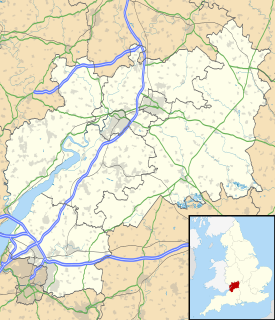
Alveston is a village, civil parish and former manor in South Gloucestershire, England, inhabited in 2014 by about 3,000 people. The village lies 1 mile (1.6 km) south of Thornbury and 10 miles (16 km) north of Bristol. Alveston is twinned with Courville sur Eure, France. The civil parish also includes the villages of Rudgeway and Earthcott.
Shropshire was established during the division of Saxon Mercia into shires in the 10th century. It is first mentioned in 1006. After the Norman Conquest it experienced significant development, following the granting of the principal estates of the county to eminent Normans.

Whittington is a village in north west Shropshire, England.

Fulk FitzWarin, variant spellings, the third, was a prominent representative of a marcher family associated especially with estates in Shropshire and at Alveston in Gloucestershire. In young life, early in the reign of King John (1199–1216), he won notoriety as the outlawed leader of a roving force striving to recover his familial right to Whittington Castle in Shropshire, which John had granted away to a Welsh claimant. Progressively rehabilitated, and enjoying his lordship, he endured further setbacks in 1215-1217.
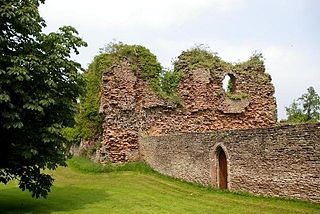
Alberbury Castle is in the village of Alberbury, some nine miles north-west of Shrewsbury, Shropshire and very close to the border with Wales. The building has been constructed from locally available red sandstone. It is a Grade II listed building.

Whittington Castle is a castle in northern Shropshire, England, owned and managed by the Whittington Castle Preservation Fund. The castle was originally a motte-and-bailey castle, but this was replaced in the 13th century by one with buildings around a courtyard whose exterior wall was the curtain wall of the inner bailey. As a castle of the Welsh Marches, it was built on the border of Wales and England very close to the historic fort of Old Oswestry.

Baron FitzWarin is an abeyant title in the Peerage of England. It was created by Writ of summons for Fulk V FitzWarin in 1295. His family had been magnates for nearly a century, at least since his grandfather Fulk III FitzWarin had recovered Whittington Castle in 1205. This castle near Oswestry was their main residence and the seat of a marcher lordship. It was regarded as situated in the county of Shropshire since 1536 and also in the Domesday Book of 1086, but for much of the intervening period was regarded as part of Wales.

Maud le Vavasour, Baroness Butler was an Anglo-Norman heiress and the wife of Fulk FitzWarin, a medieval landed gentleman who was forced to become an outlaw in the early 13th century. Part of the legend of Robin Hood might be based on him.

James Audley, 2nd Baron Audley of Heighley Castle, Staffordshire, was an English peer. He was the son and heir of Nicholas Audley, 1st Baron Audley (1289–1316) by his wife Joan FitzMartin, who was the daughter of William FitzMartin, feudal baron of Barnstaple, and Marcher Lord of Kemes. She was posthumously the eventual sole heiress of her brother William FitzMartin to Barnstaple and Kemes.
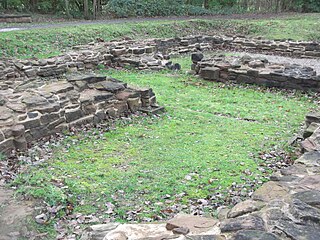
Sandwell Priory was a small medieval Benedictine monastery, near West Bromwich, then part of Staffordshire, England. It was founded in the late 12th century by a local landowner and was only modestly endowed. It had a fairly turbulent history and suffered considerably from mismanagement. It was dissolved in 1525 at the behest of Cardinal Wolsey – more than a decade before the main Dissolution of the Monasteries under Henry VIII

Josce de Dinan was an Anglo-Norman nobleman who lived during and after the civil war between King Stephen of England and his cousin Matilda over the throne of England. He was a landholder in the Welsh Marches when he was married by Stephen to the widow of Pain fitzJohn, a union that gave Josce control of Ludlow Castle. Control of the castle was contested by other noblemen, and the resulting warfare between the nobles forms the background to a late medieval romance known as Fouke le Fitz Waryn, which is mainly concerned with the actions of Josce's grandson, but also includes some material on Josce's lifetime. Josce eventually lost control of Ludlow and was granted lands in compensation by Matilda and her son, King Henry II of England, who succeeded Stephen in 1154.
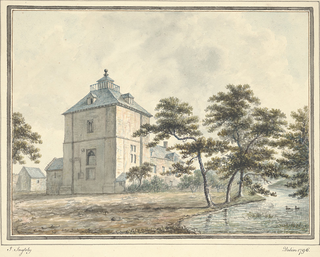
Wattlesborough Tower is a ruined fortified 13th-century manor house or Tower House in Shropshire. It is situated close to the boundary with Powys in Wales. Wattlesborough is a former township within the present parish of Alberbury. The castle is a Grade 1 listed scheduled monument. The Tower comprises a square two-storey tower above an undercroft surrounded by a moated enclosure with a fishpond. The Leighton family inherited Wattlesborough in 1471 and used it as their chief residence until circa 1711. At that time an adjoining farm building was constructed and named Wattlesborough Hall.

The feudal barony of Bampton was one of eight feudal baronies in Devonshire which existed during the mediaeval era, and had its caput at Bampton Castle within the manor of Bampton.
Fulk I FitzWarin was a powerful marcher lord seated at Whittington Castle in Shropshire in England on the border with Wales, and also at Alveston in Gloucestershire. His grandson was Fulk III FitzWarin the subject of the famous mediaeval legend or "ancestral romance" entitled Fouke le Fitz Waryn, himself the grandfather of Fulk V FitzWarin, 1st Baron FitzWarin (1251-1315).
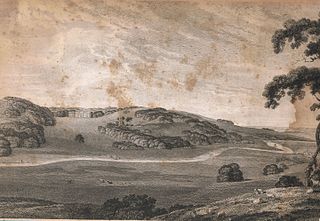
The historic manor of Tawstock was situated in North Devon, in the hundred of Fremington, 2 miles south of Barnstaple, England. According to Pole the feudal baron of Barnstaple Henry de Tracy made Tawstock his seat, apparently having abandoned Barnstaple Castle as the chief residence of the barony. Many of the historic lords of the manor are commemorated by monuments in St Peter's Church, the parish church of Tawstock which in the opinion of Pevsner contains "the best collection in the county apart from those in the cathedral", and in the opinion of Hoskins "contains the finest collection of monuments in Devon and one of the most notable in England".

Margaret II Audley was a co-heiress to the feudal barony of Barnstaple in Devon, England.
Wombridge Priory was a small Augustinian monastery in Shropshire. Established in the early 12th century, it was supported by a network of minor nobility and was never a large community. Despite generally good financial management, it fell within the scope of the Suppression of Religious Houses Act 1535 and was dissolved in the following year.

Morville Priory was a small Benedictine monastery in Shropshire, a cell of Shrewsbury Abbey.

Fulk FitzWarin, 1st Baron FitzWarin, sometimes styled as Fulk V FitzWarin, was an English landowner and soldier who was created the first Baron FitzWarin in 1295, during the reign of King Edward I.














